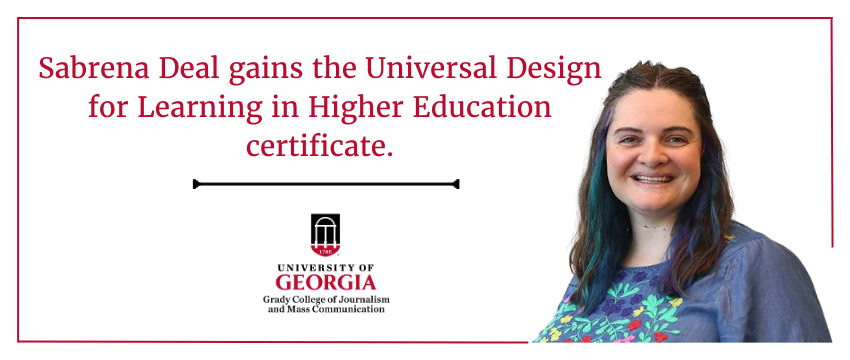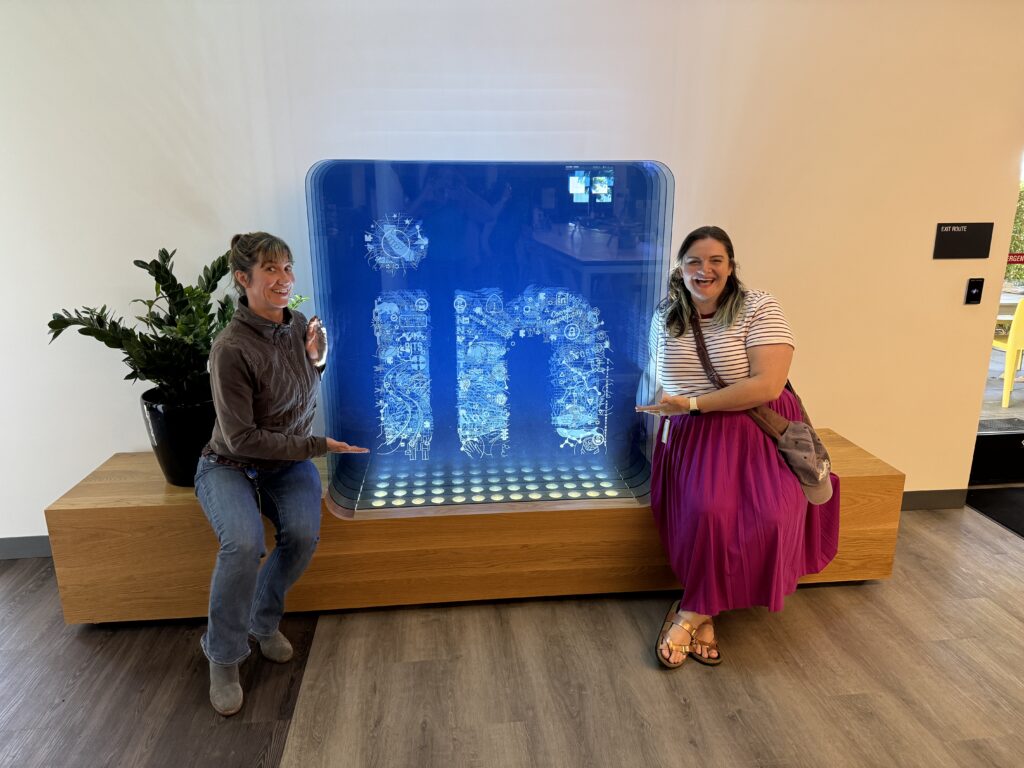Sabrena Deal shapes inclusive learning and design at Grady

Sabrena Deal shapes inclusive learning and design at Grady
As higher education evolves, inclusive teaching practices have become increasingly important.
Sabrena Deal, a senior lecturer in the Department of Advertising and Public Relations at UGA, teaches courses in Brand Strategy, Graphic Communication and Integrated Campaigns. Deal is a UGA Faculty Active Learning Leader, one of the first Peer Learning Assistant Faculty members in Grady and recently gained the Universal Design for Learning in Higher Education professional certificate. The credential equips educators to create flexible, accessible learning environments that meet the needs of every student.
In addition to her UDL work, she has developed three LinkedIn Learning courses focused on creating inclusive content, extending UDL principles to digital platforms.
Read on to learn how her efforts are shaping more inclusive practices in education.
What inspired you to be a part of this UDL professional certificate program?
I attended a panel at the 2023 UGA Active Learning Summit about Universal Design for Learning. I listened to students describe the ways their professors had accommodated their disabilities. The students described how meaningful it was for their instructors to be proactive in designing courses so that they wouldn’t have to do as much advocating for their individual accommodations. For example, one student shared about a professor making recordings of lectures available for students to review after the class periods. I’ve been doing things like this but didn’t realize there was a holistic philosophy and set of practices around it. I wanted to know more. When Erin Benson, Director of the Disability Resource Center, offered me the opportunity to be a sponsored participant, I couldn’t pass it up.
How does this certificate benefit educators in higher education specifically?
CAST, Center for Applied Special Technology, is the organization that developed the Universal Design for Learning guidelines. It developed the Credentials program to help “stimulate, support, and sustain best practices in utilizing UDL.” The higher education credential cohort I was a part of included faculty and staff from around the country. We all shared a common setting which allowed us to spend time discussing our challenges and practices with a common set of terms and shared experiences. We could focus on the work of developing our practice without having to do as much work to translate the stories of others into our jobs.
What are the core principles of UDL that the credential covers, and how are they applied in real-world classroom settings?

“The credential helps instructors, administrators, and other personnel examine the learning goals, materials, technologies, teaching methods, and assessments that together make up a curriculum.” – CAST website
Through active learning techniques like reflection, small group discussion and case-based learning, we reflected on our courses and what barriers to success may exist. We collaborated, shared resources and heard from mentors and subject matter experts around issues of accessibility , self-regulation and assessment.
What challenges do educators face when implementing UDL, and how does the certificate program help address them?
One of the challenges that educators face when implementing UDL is a shift in mindset. We have to approach courses we are very familiar with and look at them with a new perspective. That can be very difficult to accomplish, especially the further away your own experience is from the experience of college students. It takes time and intentionality to put on the mindset of another user that you don’t have much overlap with. Fortunately, this is work that I’m teaching in my classes, so I’m aware of great tools to help.
Can you share an example of how UDL can improve learning outcomes for diverse student populations?
One of my favorite things about UDL is that applying the UDL guidelines benefits the entire student population. For example, having high-quality captions on all video content may be required for a student registered with the DRC, Disability Resource Center at UGA. Perhaps the student has an audio-processing disorder. This student is supported in their learning but isn’t the only one. Students who are learning in a second or third language are supported. Students who are reviewing for an assessment and need to find a specific term can find it more quickly with captions. Applying UDL principles improves learning outcomes for every student.
How does your work with LinkedIn Learning connect with the principles of Universal Design for Learning?
My LinkedIn Learning courses are about accounting for the needs of all audience members when creating content, from the beginning. I include a chapter in the videos about Universal Design as a way to understand that welcoming everyone benefits everyone – client and audiences alike. By accounting for the diverse needs of audiences when writing, designing, embedding video and so on, every audience is better able to engage with the content.
What topics do you cover in your LinkedIn Learning courses that focus on creating inclusive content?
“Graphic design plays an important role in inclusion. Sabrena Deal describes what inclusive content is, why it’s important in today’s culture, and the benefits of being inclusive in content creation. Sabrena covers inclusive type, imagery, color, and copy for all your print and digital design work. She expands your understanding of inclusive design for websites and in video publishing.” – Introduction to Creating Inclusive Content Course on LinkedIn Learning

she filmed her live scenes at LinkedIn Learning headquarters in Carpentaria, California. (Photo: Submitted)
In higher education, it can be easy to teach about best practices in the industry without helping shape them. Through LinkedIn Learning, I’m doubling my impact. I’m making a difference in the lives of audiences while teaching my students how to do the same. It’s a natural extension of my research in Inclusive content development practices and inclusive classroom development.
In your opinion, why is it important for content to be designed inclusively for all audiences?
This is a deeply personal cause for me. One of my core personal values is the dignity of every person. I believe that each learner has something to contribute in our learning community. I want to create classroom environments that acknowledge and celebrate the experiences that each person brings to the room. I want to model for my students what it looks like to learn as I go and to work to understand and respect the needs of others.
How have you seen inclusive content practices evolve over the years, both in higher education and on digital platforms?
Federal law endorses and provides for it. The Higher Education Opportunity Act calls for instructional environments whose teaching goals, methods, materials, and assessments are based on UDL. This goes a step beyond providing assistive technology and accessible materials, which can lower barriers to access but do not necessarily provide access to learning. Many learners who are not identified as having physical, sensory, and learning disabilities may also struggle to learn due to diverse abilities and backgrounds, differing cultural and linguistic backgrounds, and other variables that affect perception, executive function, and engagement.
Final Thoughts:
For my culminating project as part of the credential, I developed a multi-activity unit on team dynamics. Group projects play a role in every course I teach. Through the credential, I recognized that I’ve been touching on the importance of groups but could do more to support this key aspect of their professional development. I implemented the unit in my campaigns class this semester and have already observed improvement!
Universal Design for Learning directly relates to UGA’s Active Learning Quality Enhancement Plan because removing the barriers in the learning environment is essential to fostering student engagement in the classroom. Our large-scale investment in Active Learning has made national news. We’re considered an aspirational institution. Being one of only a handful of faculty and staff on campus credentialed in Universal Design for Learning puts me in a unique position to enact change. It’s an exciting opportunity and I look forward to making the most of it.
Editor: Shannon Lorusso, sel67411@uga.edu